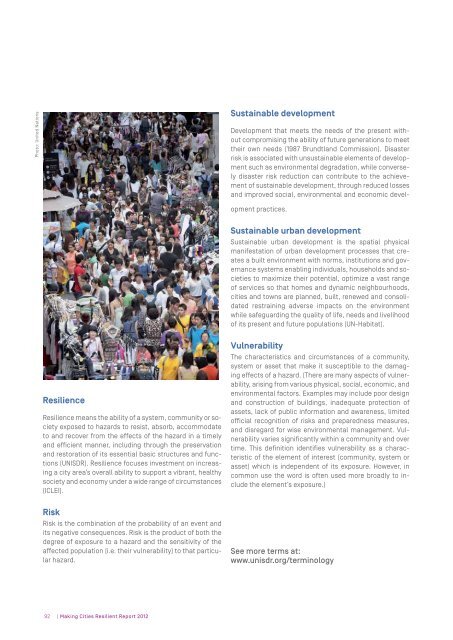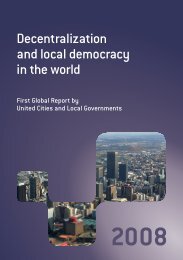Making Cities Resilient Report 2012
Making Cities Resilient Report 2012
Making Cities Resilient Report 2012
You also want an ePaper? Increase the reach of your titles
YUMPU automatically turns print PDFs into web optimized ePapers that Google loves.
Photo: United Nations<br />
Sustainable development<br />
Development that meets the needs of the present without<br />
compromising the ability of future generations to meet<br />
their own needs (1987 Brundtland Commission). Disaster<br />
risk is associated with unsustainable elements of development<br />
such as environmental degradation, while conversely<br />
disaster risk reduction can contribute to the achievement<br />
of sustainable development, through reduced losses<br />
and improved social, environmental and economic development<br />
practices.<br />
Sustainable urban development<br />
Sustainable urban development is the spatial physical<br />
manifestation of urban development processes that creates<br />
a built environment with norms, institutions and governance<br />
systems enabling individuals, households and societies<br />
to maximize their potential, optimize a vast range<br />
of services so that homes and dynamic neighbourhoods,<br />
cities and towns are planned, built, renewed and consolidated<br />
restraining adverse impacts on the environment<br />
while safeguarding the quality of life, needs and livelihood<br />
of its present and future populations (UN-Habitat).<br />
Resilience<br />
Resilience means the ability of a system, community or society<br />
exposed to hazards to resist, absorb, accommodate<br />
to and recover from the effects of the hazard in a timely<br />
and efficient manner, including through the preservation<br />
and restoration of its essential basic structures and functions<br />
(UNISDR). Resilience focuses investment on increasing<br />
a city area’s overall ability to support a vibrant, healthy<br />
society and economy under a wide range of circumstances<br />
(ICLEI).<br />
Risk<br />
Risk is the combination of the probability of an event and<br />
its negative consequences. Risk is the product of both the<br />
degree of exposure to a hazard and the sensitivity of the<br />
affected population (i.e. their vulnerability) to that particular<br />
hazard.<br />
Vulnerability<br />
The characteristics and circumstances of a community,<br />
system or asset that make it susceptible to the damaging<br />
effects of a hazard. (There are many aspects of vulnerability,<br />
arising from various physical, social, economic, and<br />
environmental factors. Examples may include poor design<br />
and construction of buildings, inadequate protection of<br />
assets, lack of public information and awareness, limited<br />
official recognition of risks and preparedness measures,<br />
and disregard for wise environmental management. Vulnerability<br />
varies significantly within a community and over<br />
time. This definition identifies vulnerability as a characteristic<br />
of the element of interest (community, system or<br />
asset) which is independent of its exposure. However, in<br />
common use the word is often used more broadly to include<br />
the element’s exposure.)<br />
See more terms at:<br />
www.unisdr.org/terminology<br />
92 | <strong>Making</strong> <strong>Cities</strong> <strong>Resilient</strong> <strong>Report</strong> <strong>2012</strong>

















